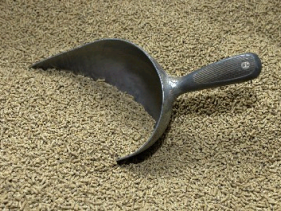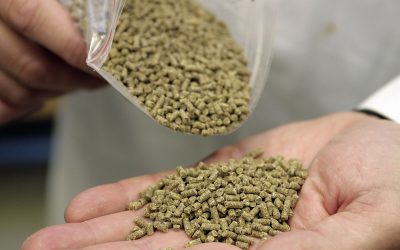US associations call for change veterinary feed directive

The American Feed Industry Association (AFIA) and National Grain and Feed Association (NGFA) have urged the Food and Drug Administration (FDA) to make “much-needed improvements” to its regulatory procedures that govern the use of certain animal drugs fed at therapeutic levels to food-producing animals.
But in a joint statement submitted recently in response to FDA’s request for comments on its so-called veterinary feed directive (VFD), NGFA and AFIA also said that even if improved substantially along the lines suggested by the two organizations, the VFD process still would be “ill-suited to serve as a vehicle for providing increased veterinarian oversight” of antimicrobial drugs previously approved by FDA for use at subtherapeutic levels.
The VFD is a written statement issued by a licensed veterinarian in the course of his or her professional practice that authorizes the use of a VFD drug to treat the client’s animals, but only in accordance with the directions for use approved or indexed by FDA. Only two VFD drugs have been approved thus far by FDA: tilmicosin, which is authorized for controlling swine respiratory disease; and florfenicol, which is authorized for controlling swine respiratory disease, control of mortality attributable to enteric septicemia in catfish and control of mortality in freshwater-reared salmonids caused by coldwater disease.
FDA has indicated it is considering utilizing the VFD to provide increased veterinary oversight of the use of previously approved antimicrobial drugs that the agency considers to be important in treating human illness. In tandem with its rulemaking on the VFD process, FDA also is soliciting public comment on draft guidance concerning the judicious use of medically important antimicrobial drugs in food-producing animals.
AFIA and NGFA said that while improvements were warranted, they supported the VFD process in enabling veterinarians to have more oversight in the selection and therapeutic use of antimicrobials that have a safety record dating to the 1950s. But the two groups said they were “extremely concerned about, and would oppose” attempts by FDA to greatly expand the application of the VFD process to currently approved non-VFD animal drugs as a means to address the issue of antibiotic resistance in humans.
The two organizations noted that commercial feed manufacturers bear the primary regulatory burden associated with administering animal drugs approved by FDA for restricted use under the VFD process. “This regulatory burden is substantial, both in terms of time and cost, with feed mills being the focal point for inspection when regulatory officials seek to determine compliance with the current VFD regulations,” NGFA and AFIA said. “If FDA were to expand the number of currently approved animal drugs that may be administered only through the VFD process, feed manufacturers would experience greatly increased paperwork burdens and regulatory compliance costs.”
AFIA and NGFA also cited concerns expressed by farm, livestock, poultry and other organizations over the severe shortage of veterinarians in many geographic areas that “would create a significant hindrance” if FDA were to attempt to expand the list of currently approved animal drugs whose distribution is subject to the VFD process. NGFA and AFIA said they recognized the public health importance of issues concerning subtherapeutic antibiotic use in food-producing animals, and strongly encouraged FDA to base future policy and regulatory decisions regarding such use on objective, substantive scientific evidence obtained through valid research. In their joint statement, AFIA and NGFA recommended several improvements to the existing VFD process for currently approved VFD drugs. Among other things, the two organizations urged FDA to:
– Eliminate the current requirement that veterinarians calculate the quantity of feed required to treat targeted animals. As an alternative, the two groups encouraged FDA to rely on the dose and duration of the VFD order.
– Eliminate the current requirement that VFD orders disseminated by fax or email by a veterinarian be followed up with an original copy within five business days. They noted that commercial feed manufacturers frequently experience difficulty obtaining the original signed VFD from the veterinarian, yet it is the feed manufacturer that is subject to potential enforcement action by FDA if this is not done. They also noted that faxes and electronically
submitted documents are accepted as originals for virtually all other legal purposes. NGFA and AFIA did oppose allowing VFD orders to be transmitted telephonically.
– Changing the records-retention requirement for VFD orders to one year, rather than the current two years. This would be consistent with the one-year record-retention requirement that applies to FDA-licensed feed manufacturers for other medicated feeds, as well as records required under the Bioterrorism Act.
– Amend existing medicated feed regulations to avoid automatically classifying VFD drugs as Category II, Type A medicated articles. This would enable FDA to classify VFD drugs in the future based upon required withdrawal times for the intended species, just as it does for all other animal drugs.
– Increase educational and training efforts among veterinarians to reduce problems associated with incomplete or inaccurate VFD orders.
In addition, AFIA and NGFA supported continued use by drug sponsors of pre-printed VFD forms, and encouraged that such forms be made available for access electronically. And the two organizations recommended that FDA use this opportunity to modify the VFD process so it can be applied to potential future scenarios involving combination drug approvals (in which just one of the drugs in the combination is a VFD product) and dual-status animal drugs (in which certain drug uses could be classified as requiring a VFD while other uses of the same drug would not).











